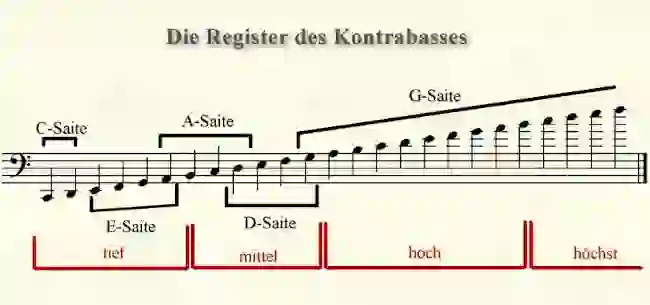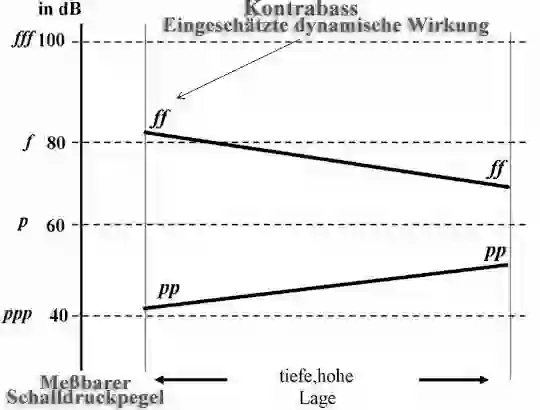Sound character of the double bass - Philipp Dangas
Register table of the double bass
The double bass's proportions are not as ideal as those of the violin or the cello's proportions.
This is expressed, among other things, in the length, strength and tension of the strings as well as in the shape of the body of the double bass. The first resonating overtones appear particularly strongly in the sound of the double bass. They are the reason for the fullness and power of the double bass' sound.
In the orchestral setting, the independent sound function of these overtones must be carefully observed. They have the property of dampening the sound of other instruments that do not have a strong sound rich in overtones.
As part of the „symphonic world music“
The double bass is a secondary instrument of the string group. The main task of the double bass is to make the overall sound more massive, to give it a special intensity.
Table summary of the sound character of the double bass
The timbres of the double bass are shown in the following table briefly described. And the sound character it creates.
Dynamic effect of the double bass
Sheet music for the dynamic table from the double bassLet's consider the following representation of the dynamic table. It indicates the degree of strength of musical dynamics. In addition to the sound pressure scale measured in decibels [dB], the degrees of strength of musical dynamics are given on the left, which can be understood as "objective" degrees.
Now to the diagram drawn, to the right of the dB scale. It shows the estimated dynamic effect over the entire tonal range of the instrument. The dynamic effect (volume) as judged (perceived) by the listener.
And now an example: In the low register of the trumpet, the dynamic range between pianissimo [pp] 46 decibels [dB] and fortissimo [ff] 82 decibels [dB] = 36 decibels [dB]. In the high register, the range is 8 decibels [dB]. The estimated values can deviate more or less from the "objective" ones.
The deviations between the instruments are fundamentally different. The “objective” strength levels mentioned, such as piano pianissimo [ppp]= 40 decibels [dB], p=60 decibels [dB] etc., enable the composer to predict the dynamic effects of different instruments that are sounding simultaneously.
Table summary of the dynamic range of the double bass
The following table shows the achievable dynamic range of the double bass shown. The span is the difference between the fortissimo and the Pianissimo in the same pitch.

The double bass register table in large format
- G string (1st string)
- Good for solos and flageolets, quite soft-toned
- D string (2nd string)
- Most used, marked with a typical bass sound.
- A string (3rd string)
- Powerful bass sound, ideal for the orchestra.
- E string (4th string)
- Heavy and dark, quite unclear in fast passages.
- H string (5th string)
- Extremely dark, not suitable for fast passages.

The dynamic table from the double bass
Internal search function
| Name | Value | Delete |
|---|